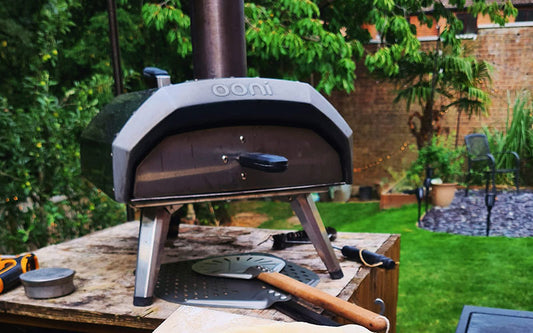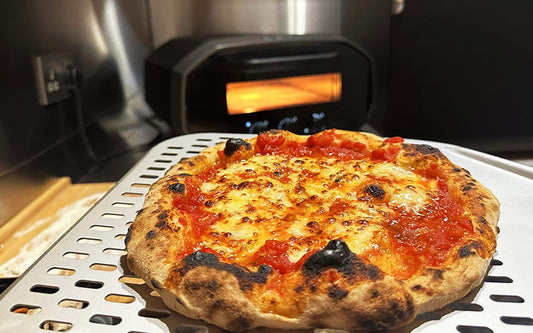The secret to making a perfect pizza lies not just in the dough and toppings but also in the equipment you use. And when it comes to equipment, nothing is more important than a good quality pizza stone. But what happens when your trusty pizza stone starts looking less than perfect?
The best way to deep clean a pizza stone is by using a mixture of baking soda and water to create a paste. You can also use salt or semolina to scrub off the burnt food bits. However, on most days, I just let the stone sit in a 650F oven for 45 minutes. The intense heat burns off all the dirt and grime.
Now that you know the basics of cleaning your pizza stone, let’s dive deeper into the topic. From avoiding soap and detergent to heat treatment, I’ll cover everything you need to know about pizza stone cleaning.
Importance of Maintaining a Clean Pizza Stone
Remember that with great bakeware comes great responsibility. In this section, I’ll discuss the importance of maintaining a clean pizza stone.
1. Prevents Contamination and Foodborne Illnesses
Maintaining a clean pizza stone is crucial to prevent the buildup of pathogens.
A dirty pizza stone can harbor bacteria that may transfer to your pizza during cooking. To avoid this, make sure you clean your pizza stone thoroughly after each use.
2. Ensures Even Cooking and Crispy Crusts
A dirty pizza stone can affect the texture and flavor of your pizza. The buildup of grease and food particles on the surface of the stone can cause uneven cooking and lead to soggy or burnt crusts. By keeping your pizza stone clean, you’ll ensure even heat distribution during the baking.
3. Extends the Lifespan of the Pizza Stone
Cleaning your pizza stone regularly can help prolong its lifespan. This will save you money in the long run. Over time, residue from cheese, sauce, and other toppings can build up on the surface of the stone. This can cause it to become brittle and crack with frequent use.
By removing these residues after each use, you’ll prevent this damage from occurring and extend the life of your pizza stone.
4. Preserves the Flavor of the Pizza
A dirty or greasy pizza stone can negatively affect the taste of your homemade pizzas. The residual oils from previous bakes can mix with fresh ingredients and alter their flavors or create an unpleasant smell.
Cleaning your pizza stone properly ensures that there are no lingering smells or flavors left behind from previous bakes.
5. Saves Time and Effort in Future Cleanings
Regular cleaning reduces future efforts by preventing stubborn stains from building up over time. Dirt buildup ultimately leads to longer cleaning times in later stages.
4 Effective Methods for Cleaning a Pizza Stone
I’ve experimented with numerous methods for cleaning pizza stones over the years. In this section, I’ll share with you my top three tried-and-true methods for keeping your pizza stone in tip-top shape.
1. Scraping With an Oven Brush or Spatula for a Quick Cleanup
One of the most common issues that home chefs face when it comes to cleaning their pizza stones is removing stubborn burnt food bits. To tackle this problem, start by using an oven brush, spatula, or butter knife to scrape off any large pieces of debris.
Then, dampen a non-abrasive scrubber with warm water and use gentle circular motions to remove any remaining residue. Avoid using soap or other cleaning agents, as these can seep into the porous surface of the stone and affect its ability to retain heat.
2. Baking Soda and Water for Deep Cleaning
For tougher stains that won’t budge with just water alone, baking soda can be a game-changer. Mix 3 tbsp of baking soda and ½ cup of water together to create a paste-like consistency.
Apply the mixture onto your pizza stone and let it sit for 10 minutes before rinsing it off with warm water. This method is especially effective at removing grease buildup on your pizza stone.
3. Heat Treatment to Disinfect the Stone
Another effective way to clean and disinfect your pizza stone is by baking it at the highest temperature setting for 30-60 minutes. I let my Ooni pizza stone sit in the oven at max temp for about 30 minutes.
For my electric oven, the duration is 45 minutes at 650 F. If your oven’s max temp is 500F, increase the time to one full hour.
The heat will help burn off any leftover food particles or grease on the surface of your stone, leaving it looking brand new once again! Make sure you allow your pizza stone to cool down completely before handling it after this method.
4. Cleaning With Salt or Semolina for Odor and Soot Removal
Another method that has proven to be highly effective in cleaning a sooty, burnt pizza stone is using salt. Not only is this method easy and affordable, but it’s also gentle on your pizza stone and won’t damage its surface.
To start, let your pizza stone cool down slightly before cleaning it. The method works better if the stone is still warm to the touch.
Sprinkle a generous amount of kosher salt on top of the stone. Make sure that you cover the entire surface area of the stone with salt. Take a damp cloth, brush, or sponge to scrub the salt into the surface of the stone.
The salt acts as an abrasive agent and helps to remove any stubborn stains or residue that may be stuck on your pizza stone. You can also use semolina for more stubborn particles.
After scrubbing with salt or semolina, wipe away the residue with a damp cloth or sponge. Rinse under running water if necessary and dry thoroughly before storing it away.
I personally love using this method. It not only cleans my pizza stone effectively but also helps eliminate any unwanted odors that may linger after cooking.
Tips for Cleaning Other Types of Pizza Stones
The above-mentioned tips work well for unglazed ceramic and cordierite baking stones, but what about other types of stones?
Tips for Cleaning Glazed Pizza Stone
Unlike unglazed pizza stones, the glazed counterparts don’t absorb chemicals or moisture. Therefore, it’s safe to wash them with soap and other cleaning solutions. If you are going to use the pizza stone regularly, I would strongly recommend investing in a glazed stone.
For stubborn stains and odor, soak it in a solution of hot water and vinegar for approximately 10 minutes. Afterward, you can either wash it by hand or place it in the dishwasher.
Tips for Cleaning a Stainless Steel Pizza Stone
Bar Keepers Friend is an excellent cleaning solution for stainless steel pizza stones.
Start by immersing your stainless steel pizza stone in warm water. Then, create a paste using Bar Keepers Friend and water. Apply the paste to your pizza stone using a soft cloth and rub it in gently with circular motions working from the center outward.
Don’t Miss: How to Clean Ooni Pizza Stone? [Here’s My Secret Trick!]
Be sure not to let the paste sit for more than one minute. After a minute, wash off the residue with hot soapy water and dry it completely.
When cleaning your stainless steel pizza stone, always use nylon scrubbing pads to avoid scratching its surface. Never use steel wool or steel scouring pads as these can damage its surface.
Tips for Cleaning Soapstone Pizza Stone
Soapstone pizza stones are a popular choice for many pizza enthusiasts because of their unique properties. Unlike regular pizza stones, soapstone is non-porous and retains heat exceptionally well.
To clean a soapstone, remove any large chunks of food from its surface using a blunt knife or metal spatula. Once you’ve done this, warm water and mild detergent to wash out the debris.
Once a month, create a mixture of equal parts water and white vinegar in a spray bottle. Spray the solution onto the surface of the soapstone pizza stone and let it sit for about 10-15 minutes. This will help break down any stubborn stains or burnt bits of food.
Afterward, rinse off the solution with warm water and dry the soapstone pizza stone thoroughly with a clean towel. It’s important not to let your soapstone pizza stone air dry as this can cause cracking or damage.
Tips for Cleaning a Cast Iron Pizza Stone
In my experience, the most effective way to clean a cast iron pizza stone is by using salt. As someone who has been using this method for years, I can attest to its effectiveness in removing stains and badly stuck burnt bits of food.
Start by allowing your pizza stone to cool down completely after use. Then sprinkle some coarse salt onto the surface of the stone while it’s still warm. Use a paper towel or a soft-bristled brush to gently scrub away any debris or burnt bits of food.
After you’ve removed all the debris from the surface of your pizza stone, rinse it thoroughly with hot water. It’s important not to use soap as this can remove the seasoning on your stone.
Note that cleaning a pizza stone with salt should only be done occasionally as overuse can damage the seasoning on the stone.
Can Pizza Stones Get Moldy?
Unfortunately, yes. Pizza stones can get moldy if they’re not cleaned and stored properly. Mold thrives in warm, moist environments, making your pizza stone the perfect breeding ground if it’s not taken care of correctly.

One way to prevent mold from growing on your pizza stone is to ensure that it’s completely dry before storing it away. After cleaning your pizza stone with hot water and a soft-bristle brush or scraper, allow it to air dry thoroughly before putting it away.
If you don’t have time to let it air dry completely, you can also dry it off with a clean towel or paper towel.
Another way to prevent mold from growing on your pizza stone is by curing it regularly with vegetable oil (only applicable for cast iron stones). The seasoning creates a protective layer. This prevents moisture from creating an environment for mold growth.
What About the Germs and Bacteria?
The good news is that due to their high heat retention, pizza stones are actually quite hygienic and safe to use. When you heat up your pizza stone in the oven, it reaches temperatures of up to 500°F or higher, which is hotter than most pathogens can survive.
This means that any bacteria or germs present on the surface of the stone will likely be killed off during the preheating process.
Tips for Drying and Storing a Pizza Stone Correctly
Moisture and pizza stones aren’t the best of friends.
So make sure that the pizza stone is completely dry before storing it away. Any leftover moisture can potentially lead to mold growth.
If you are using a little bit of water to clean the store, make sure to wipe it with a dry towel. Then let it air dry for a couple of hours before storing it away.
To store your pizza stone properly, place it in a cool, dry place where it won’t be exposed to direct sunlight or moisture. You can wrap your pizza stone in a clean towel or cloth bag to protect it from dust and debris while in storage.
Make sure not to stack anything heavy on top of your pizza stone during storage. This can potentially crack or damage the surface of the stone. Instead, store your pizza stone flat on a shelf or rack where it won’t be disturbed until you’re ready to use it again.
How to Make Your Pizza Stone Last Longer?
Pizza stones can last for a good few years before they start showing signs of wear and tear. Here are a few expert-approved tips to extend the lifespan of a pizza stone:
- Place a sheet of parchment paper or pizza screen under the dough to keep your pizza stone looking new for a long, long time.
- Resist the urge to season your stone with oil, unless it’s made of cast iron. Other baking stones get darker and develop a patina after a couple of uses.
Patina is essentially a seasoned surface that develops over time with use, created by oils and fats from the food cooked on it. It can enhance the flavor of the crust and prevent sticking and burning.
- Never ever use soap, detergent, or any chemical cleaning solutions for cleaning unglazed stones.
- Do not submerge the stone in water, ever!
- Always use a non-abrasive scrubber for scrubbing the surface.
How to Season a New Pizza Stone?
Most pizza stones don’t require any seasoning at all. So be sure to check the manufacturer’s instructions before seasoning it yourself. If your pizza stone is already seasoned, you can simply wipe it down with a damp cloth and begin using it.
If the manufacturer recommends seasoning the brand-new stone, do this:
Lightly coat it with vegetable oil or another high-smoke point oil. Then heat it in the oven for about an hour at a temperature of 400-450°F (204-232°C). After an hour, turn off the oven and let the stone cool completely before using it.
Related FAQs
Can You Wash a Pizza Stone in the Dishwasher?
No, I don’t recommend washing a pizza stone in the dishwasher. Pizza stones are made of porous material. So, harsh detergents used in dishwashers can damage or crack the stone.
Can I Pressure Wash a Pizza Stone?
Absolutely not. Pizza stones should always be gently hand-washed.
How Often Should You Clean a Pizza Stone?
It’s best to clean your pizza stone after each use. This will prevent any leftover food or debris from building up and affecting the taste of your next pizza.
In Conclusion
Cleaning your pizza stone is an important step in ensuring that your pizzas always turn out delicious. While it’s best to clean the stone after each use, giving it a deeper clean every once in a while can help keep it in top condition.
Remember to avoid using soap or other harsh chemicals, and never put it in the dishwasher. With these tips in mind, you’ll be able to prolong the lifespan of your pizza stone.






